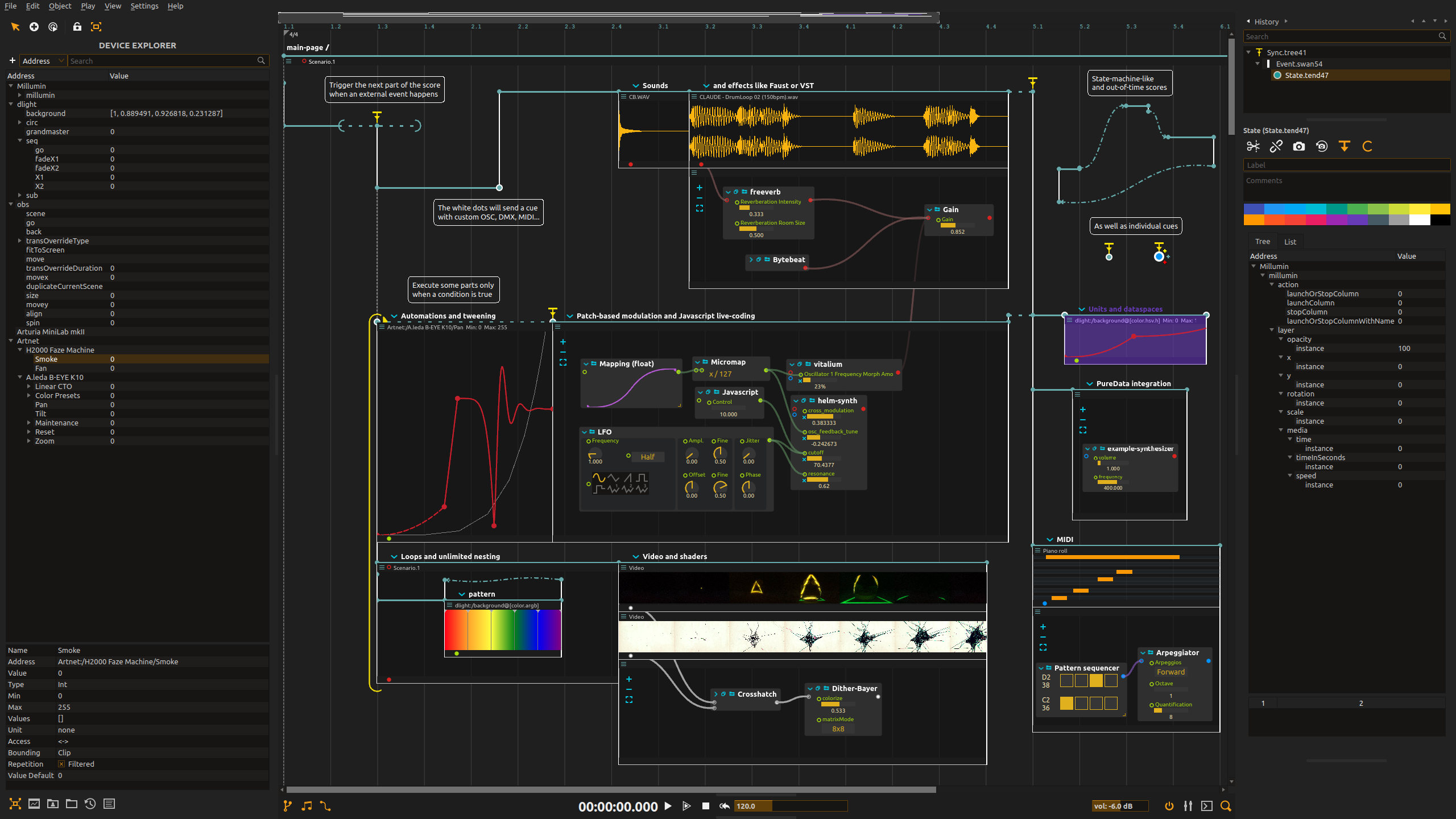About ossia score
ossia score is a sequencer for audio-visual artists, designed to enable the creation of interactive shows, museum installations, intermedia digital artworks, interactive music and more in an intuitive user interface.

It allows to sequence OSC, MIDI, DMX, sound files and more, between multiple software and hardware. Its novel interactive timeline enables scores written with it to depend on external events and controls through a simple visual language.
ossia score is free, libre & open source software and runs on desktop (Windows / macOS / Linux), mobile and embedded. It leverages libossia for its implementation, as well as reputed open-source technologies such as Qt 5, Boost and LLVM. It is written primarily in modern C++.
License
ossia score is distributed under the terms of the CeCILL license. The french CeCILL license allows the software to be used under the terms of the GNU GPLv3.
Funding
You can fund the development of ossia on OpenCollective.
Structure
Automation
 Discover how to automate internal and external parameters
Discover how to automate internal and external parameters
Conditions
 Create conditional scores
Create conditional scores
Cues
 Sending cues to control a show
Sending cues to control a show
Graphs
 Creating state machines and graphs
Creating state machines and graphs
Loops
 Creating loops
Creating loops
Nesting
 Nesting scores with the scenario process
Nesting scores with the scenario process
Modular workflow
 Cables, ports, nodal view...
Cables, ports, nodal view...
Recording
 Recording external parameter changes
Recording external parameter changes
Temporal workflow
 Creating and editing scenarios
Creating and editing scenarios
Sequences
 Creating sequences
Creating sequences
Triggers
 Interactive triggering
Interactive triggering
Audio
Sound files
 Playing sound files in ossia score
Playing sound files in ossia score
Audio plug-ins
 Using audio plugins in ossia score
Using audio plugins in ossia score
Bytebeat
 Dope 8-bit sound generator
Dope 8-bit sound generator
Faust
 Using Faust to create advanced audio processes
Using Faust to create advanced audio processes
Audio looper
 Recording and playing back audio
Recording and playing back audio
MIDI
 MIDI input & output, piano roll & MIDI effects
MIDI input & output, piano roll & MIDI effects
Mixing
 Audio mixing, audio workflow and hierarchy
Audio mixing, audio workflow and hierarchy
Controls
Control surface
 Using the control surface to keep an hand on score parameters
Using the control surface to keep an hand on score parameters
Controlling score
 Controlling score execution from external software
Controlling score execution from external software
LFO
 Modulate any parameter in the score
Modulate any parameter in the score
Mapping processes
 Mappings in the timeline
Mappings in the timeline
Step sequencer
 Using the step sequencer process
Using the step sequencer process
Graphics
Camera
 Use a camera as an input for VJ
Use a camera as an input for VJ
Shaders
 Using and writing ISF shader effects
Using and writing ISF shader effects
Generative textures
 Using C++ scripts
Using C++ scripts
Video
 Video support and usage
Video support and usage
Interoperability
Gamepads
 Using gamepads and wiimotes in a score
Using gamepads and wiimotes in a score
Local tree
 Controlling ossia score with the local device tree
Controlling ossia score with the local device tree
Mapper device
 Mappings between devices
Mappings between devices
OSC
 Send and receive OSC messages
Send and receive OSC messages
OSCQuery
 Using OSCQuery for automatic discovery of OSC devices
Using OSCQuery for automatic discovery of OSC devices
Remote control
 Remote control through a web page
Remote control through a web page
Serial port
 Interaction through a serial port (Arduino, etc.)
Interaction through a serial port (Arduino, etc.)
Presentation
Scripting
Command line API
 Options for the score start-up
Options for the score start-up
Script console
 Scripting workflows with the console
Scripting workflows with the console
Javascript
 Writing JavaScript processes
Writing JavaScript processes